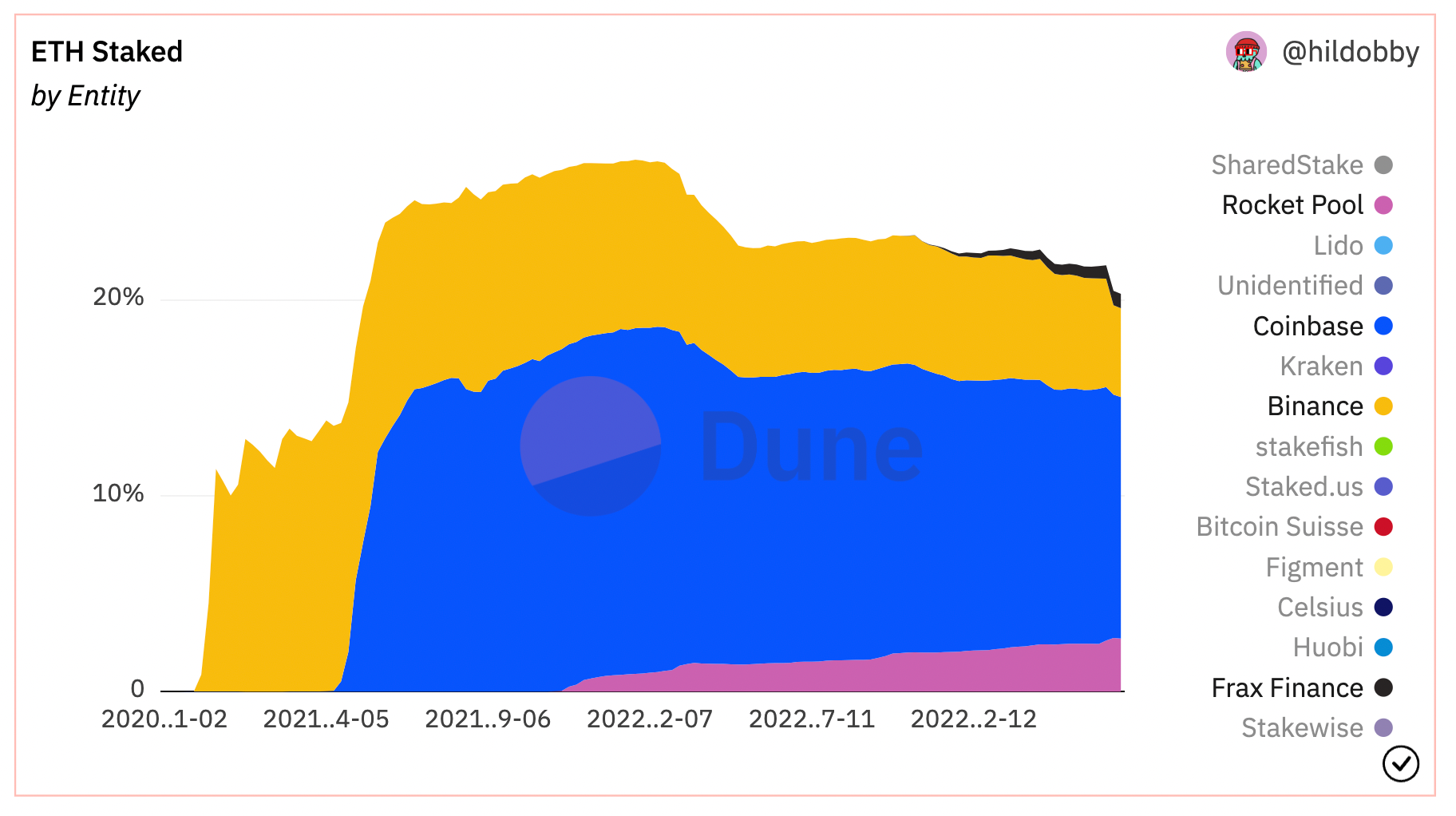Centralized crypto exchange giants Binance and Coinbase have suffered large outflows of staked ether (ETH) since Ethereum’s Shanghai upgrade as investors flock to decentralized rivals, blockchain data shows.
Coinbase’s staking platform has endured a $367 million net outflow of staked ETH since April 12, as withdrawal requests – including reward withdrawals and full exits – outpaced new deposits, according to a Dune Analytics data dashboard. The world’s largest crypto exchange Binance’s staking service has seen a net outflow of $340 million.
Decentralized liquid staking protocols, on the other hand, have enjoyed a sharp rise in deposits. Frax Finance and Rocket Pool, the two of the largest gainers, have recorded net inflows of $56 million and $68 million, respectively.
The development has followed Ethereum’s highly anticipated Shanghai upgrade on April 12, which allowed investors to withdraw some $35 billion of tokens previously locked up in staking contracts. Analysts predicted that the event would be a major milestone for the $225 billion network, likely boosting staking participation, attracting institutional investors and reshuffling the competition between staking services.
The upgrade has been “a major catalyst” for decentralized liquid staking solutions, Ahmed Ismail, founder and chief executive of liquidity aggregator platform FLUID Finance, said.
Liquid staking protocols issue a derivative token that represents the amount of locked tokens and lets investors access decentralized finance (DeFi) services such as lending and borrowing.
Boosted by new deposits, the amount of ETH staked on Frax and Rocket Pool has grown 32.5% and 31% in the past 30 days, respectively, according to DefiLlama data.
Lido Finance, the largest decentralized liquid staking protocol with some $11 billion of deposits, has also booked some $28 million (15,208 ETH) more deposits than withdrawals since April 12.
Regulatory concerns, higher yields
Regulatory risks and aversion to centralized crypto platforms after last year’s bankruptcies are likely among the reasons that drive investors to decentralized staking protocols, Tom Wan, an analyst at digital asset investment firm 21Shares, said in a note.
This February, crypto exchange Kraken agreed to shutter its staking service after the U.S. Securities and Exchange Commission (SEC) charged the exchange for offering unregistered securities. Liquid staking tokens surged following the settlement as the SEC appeared to come after staking service providers, benefitting decentralized liquid staking.
Regulatory pressure on centralized entities may continue, John “Omakase” Lo, head of digital assets at investment firm Recharge Capital, said.
“The uncertainty isn’t good for retaining deposits,” he added.
Investors could also be swayed by higher staking rewards that decentralized protocols can provide. Currently, Coinbase and Binance offer around 4% annualized reward for staking ETH, whereas decentralized protocols Lido Finance and Frax Finance provide 5-7% rates.
“Centralized liquid staking usually has a lower yield profile. Compliance and staffing all add up,” Omakase said.
Market share of ETH staking protocols (Hildobby.eth/Dune Analytics)
Despite recent outflows, Binance and Coinbase remain among the largest ETH staking providers. However, Binance’s market share fell to 4.5% from 5.7% a month ago, while Coinbase’s share dropped to 12.3% from 13%.
The two exchanges face further outflows, data by blockchain intelligence firm Nansen shows. Coinbase has some $191 million of staked ETH waiting to be withdrawn, while Binance has $41 million in withdrawal requests in its queue.
All writers’ opinions are their own and do not constitute financial advice in any way whatsoever. Nothing published by CoinDesk constitutes an investment recommendation, nor should any data or Content published by CoinDesk be relied upon for any investment activities. CoinDesk strongly recommends that you perform your own independent research and/or speak with a qualified investment professional before making any financial decisions.
Recommended Content
Editors’ Picks

Ethereum Price Forecast: ETH ETFs total net assets plummet over 60%; Justin Sun says he won't sell ETH
Ethereum traded just below $1,600 on Thursday following a 60% plunge in the total net assets of US spot Ether ETFs.

Binance Coin price nears $600 breakout as CZ reacts to BNB listing on Kraken
Binance Coin price posted considerable gains on Thursday, fuelled by investor optimism tied to its upcoming listing on the U.S.-based crypto exchange Kraken.

Binance CEO affirms company's involvement in advising countries on Bitcoin Reserve
Binance CEO Richard Teng shared in a report on Thursday that the cryptocurrency exchange has advised different governments on crypto regulations and the need to create a strategic Bitcoin reserve.

Slovenia moves to impose 25% tax on crypto traders
Slovenia has become the latest European Union member state to crack down on untaxed crypto gains, unveiling a proposal to impose a 25% tax on personal profits from digital asset disposals starting in 2026.

Bitcoin Weekly Forecast: Market uncertainty lingers, Trump’s 90-day tariff pause sparks modest recovery
Bitcoin (BTC) price extends recovery to around $82,500 on Friday after dumping to a new year-to-date low of $74,508 to start the week. Market uncertainty remains high, leading to a massive shakeout, with total liquidations hitting $2.18 billion across crypto markets.

The Best brokers to trade EUR/USD
SPONSORED Discover the top brokers for trading EUR/USD in 2025. Our list features brokers with competitive spreads, fast execution, and powerful platforms. Whether you're a beginner or an expert, find the right partner to navigate the dynamic Forex market.
